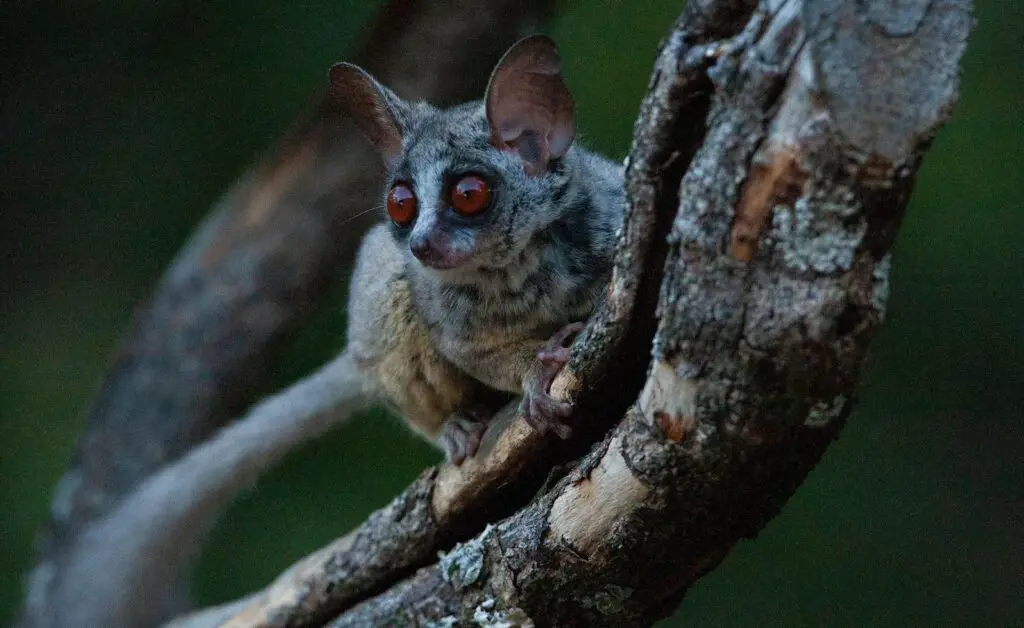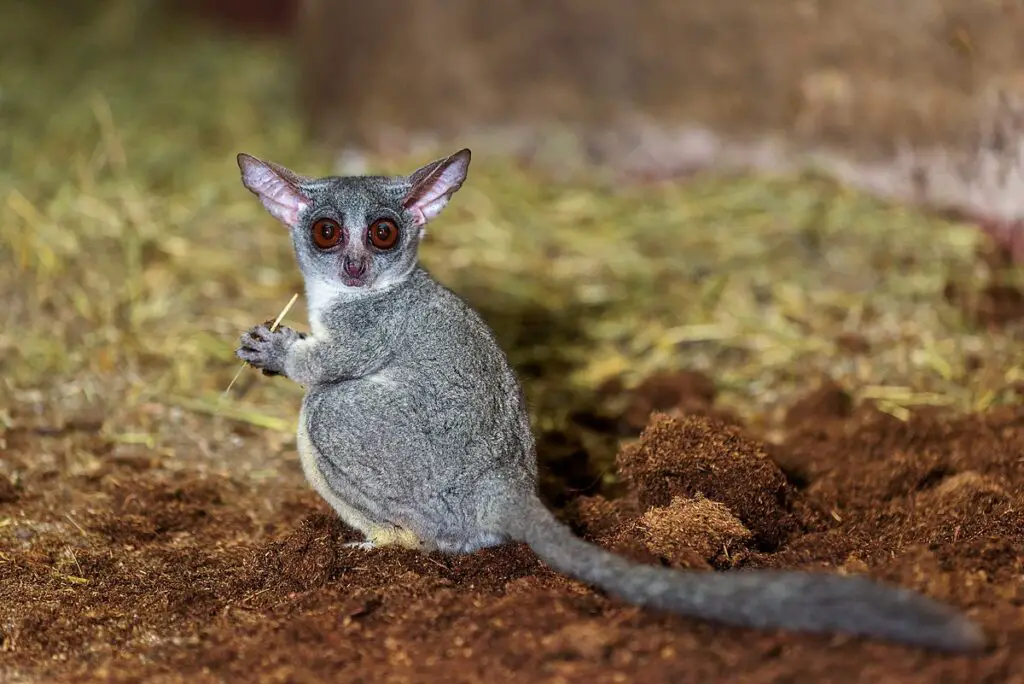Table of Contents
ToggleIntroduction

Bush babies, also known as galagos, are captivating creatures that inhabit the diverse landscapes of Africa. These small, nocturnal primates hold a unique place in the animal kingdom, boasting fascinating features and behaviors that make them remarkable. As we delve into the world of bush babies, we will uncover their distinctive physical characteristics, gain insight into their preferred habitats, and explore the intriguing intricacies of their daily lives.
Physical Characteristics
In the intricate tapestry of Africa’s wildlife, bush babies stand out as captivating nocturnal jewels. Their physical characteristics are charming and uniquely adapted to their specialized way of life. From their size and appearance to their remarkable sensory adaptations, let’s uncover the fascinating physical traits that define these small primates.
A Glimpse of Size and Appearance
Bush babies are a study in contrasts, blending delicate features with a hint of otherworldly charm. Their length is typically between 6 and 12 inches (15 and 30 cm) because of their long, bushy tails. Despite their diminutive stature, they possess a cuteness that belies their wild nature.
Their fur ranges from shades of gray and brown to reddish hues, helping them blend seamlessly with the dappled light of their forest homes. This cryptic coloration serves as camouflage and a visual delight, attracting the attention of observers fortunate enough to glimpse these elusive creatures.
The Power of Night Vision
The most striking feature of bush babies is their large, luminous eyes. These eyes are uniquely adapted for their nocturnal lifestyle, enabling them to see in conditions that would render most animals blind. The tapetum lucidum, a reflective layer beneath the retina, helps them see in the dark by reflecting light through the retina for a second chance to collect photons.
This exceptional night vision is critical for navigating the darkness, spotting potential prey, and avoiding predators. It allows bush babies to explore their environment with relative ease during the darkest hours, giving them a competitive edge in the struggle for survival.
Ears Tuned to Perfection
As the moonlight filters through the leaves, bush babies’ oversized ears become vital instruments in deciphering the night’s symphony. Their auditory senses are exquisitely honed, enabling them to detect even the faintest sounds of rustling leaves, scampering insects, or the distant calls of other animals. These large ears amplify sound waves, allowing them to be attuned to the subtlest nuances of their surroundings.
This heightened sense of hearing serves multiple purposes. Not only does it aid in locating food, but it also helps bush babies detect potential threats approaching from afar. Their ability to pick up on the faintest sounds makes them expert hunters and evaders, contributing to their survival in the wild.
Climbing and Leaping Mastery
Another remarkable physical adaptation of bush babies lies in their limbs. Their hind limbs are notably more extended and powerful than their forelimbs, allowing them to leap incredible distances with astonishing accuracy. This unique adaptation will enable them to traverse the intricate web of branches that make up their arboreal homes.
Their hands and feet possess specialized adaptations for gripping onto branches, giving them the confidence to explore their vertical world without fear of falling. The combination of their leaping ability and their adeptness at climbing makes bush babies true masters of their treetop habitat.
A Symphony of Senses
In African night, bush babies rely on extraordinary physical traits to navigate their environment, secure food, and communicate with their peers. From their large, luminous eyes and oversized ears to their nimble limbs built for leaping, these characteristics are not merely adaptations.
They’re a testament to the wonders of evolution and the remarkable diversity of life on our planet. In the upcoming chapters, we’ll delve deeper into the behavioral intricacies of these captivating creatures, shedding light on their nocturnal habits, social dynamics, and more.
Habitat And Distribution
In the heart of Africa’s diverse landscapes, bush babies find their niche, weaving their lives into the tapestry of the continent’s ecosystems.
Their preference for specific habitats and their ability to adapt to various environments make them an intriguing study in ecological specialization. Join us as we venture into the dense forests, woodlands, and savannas that serve as the backdrop to their captivating lives.
Exploring Their African Range
Bush babies have secured their place across various African territories, each region offering unique challenges and opportunities. From the tropical rainforests of Central Africa to the dry savannas of the eastern and southern parts of the continent, these agile primates have adapted to diverse environments, showcasing their remarkable flexibility.
The Forests: A Canopy Retreat
One of the preferred habitats for bush babies is the dense forest. The towering trees of these forests provide them with abundant opportunities for shelter, safety, and sustenance. The lush vegetation offers an intricate maze of branches, allowing these agile creatures to navigate their treetop homes easily. The forest’s canopy also shelters them from the prying eyes of predators that roam below, ensuring their safety as they forage and explore.
Woodlands and Savannas: Balancing Act
Bush babies are not confined to the embrace of forests alone; they thrive in woodlands and savannas. These habitats may lack the dense canopy of the rainforests, but they present their advantages.
The ability to move between trees and the ground gives bush babies a unique edge in these environments. Here, they can feast on a diverse array of insects, fruits, and other resources while adapting to the changing conditions of their surroundings.
Dependence on Trees
Regardless of the habitat they call home, trees play an indispensable role in the lives of bush babies. Not only do they provide shelter and safety, but they also serve as sources of food.
From the sweet gums oozing from tree bark to the array of fruits that dangle temptingly from branches, trees offer a variety of sustenance that keeps these primates fueled and thriving.
Harmony in Diversity
The adaptable nature of bush babies is a testament to their ecological flexibility. They have evolved to make the most of the opportunities presented by various habitats, blending seamlessly into the natural rhythms of Africa’s diverse ecosystems.
This ability to thrive in different environments highlights their role as integral members of their ecosystems, contributing to the delicate balance of the food chain and the intricate connections that link all living things.
Behavior And Lifestyle
Within the moonlit embrace of African nights, bush babies emerge, revealing a world of intricate behaviors and captivating lifestyles. As creatures of the dark, they’ve developed a unique set of behaviors that enable them to thrive in the cover of night. In this chapter, we venture into their secretive realm, unveiling the nocturnal rituals that define their existence.
Nocturnal Wonders
Bush babies are actual creatures of the night, their lives intricately intertwined with the rhythm of darkness. As the sun sets and the natural world transitions from day to night, these primates awaken from their slumber, ready to seize the opportunities the night offers. Their large, light-amplifying eyes and finely-tuned ears become their guides in navigating the shadows, allowing them to hunt, communicate, and explore with remarkable efficiency.
Arboreal Dwellers
The treetops are where bush babies genuinely come into their own. These primates are well adapted to an arboreal lifestyle, spending most of their time within the intricate maze of branches and foliage. Their limbs evolved for climbing and leaping, enabling them to move nimbly through the trees, where they find both safety from ground-dwelling predators and a diverse array of food sources. Their agile movements are a testament to their mastery of their chosen habitat.
Solitary or Social?
Bush babies are complex in social behaviors, often displaying solitary and social tendencies. While they are known to be solitary foragers, occasionally coming together in pairs or small family groups, their social interactions play a crucial role in communication and reproduction.
They communicate through vocalizations, from soft calls to high-pitched screams, which help establish territories, signal danger, and attract potential mates.
The Art of Communication
Vocalizations are not the only means of communication for bush babies. They also communicate through body language, scent marking, and grooming. Scent glands on their wrists mark their territory, ensuring their presence is known to other bush babies. Grooming serves a dual purpose: maintaining hygiene and reinforcing social bonds between individuals.
Adaptations for Survival
In the wild world of survival, bush babies have honed specific adaptations that give them an edge. Their diet, which includes a variety of insects, fruits, and gums, ensures they can take advantage of the resources available in their habitat.
Their remarkable leaping ability allows them to swiftly escape predators, while their camouflage and nocturnal behaviors minimize their risk of being detected by day-active animals.
Embracing the Night
In the following chapters, we’ll delve deeper into the intricacies of bush baby behavior, uncovering their dietary habits, exploring their reproductive cycles, and unraveling their cultural significance in various African societies.
The night holds a world of secrets and enchantment, and as we peer into the shadows, we’ll understand how bush babies have skillfully woven their lives into the fabric of Africa’s nocturnal wonders.
Conclusion
A nocturnal enigma in the heart of Africa’s diverse ecosystems unfolds under darkness. The bush baby, with its captivating physical characteristics, specialized habitats, and intricate behaviors, stands as a testament to the wonders of the natural world. Through the chapters of this exploration, we have unveiled the layers of their existence, revealing a tapestry of life that is as beautiful as it is mysterious.
From their luminous eyes that pierce the night to their agile leaps that carry them through the treetops, bush babies embody adaptation. Their ability to navigate the challenges of various habitats showcases the brilliance of evolution, reminding us of the resilience and diversity of life on Earth.







